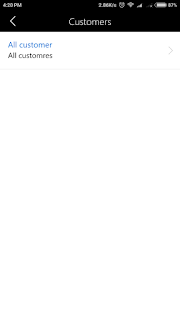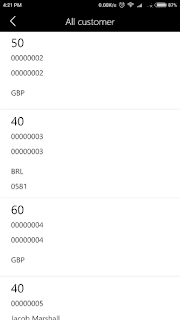Hi Folks,
In my previous post I shared test code to upload bulk images in AX through X++ code. Here is another set of code to achieve the same.
Create a new class with below methods.
class ImageImport extends RunBase
{
// Packed variables
FilePath filePath;
NoYesId setDefault;
ItemIdEANExternalItemIdRadio itemIdEANExternalItemIdRadio;
VendAccount vendAccount;
// Dialog fields
DialogField dlgfilePath;
DialogField dlgsetDefault;
DialogField dlgitemIdEANExternalItemIdRadio;
DialogField dlgVendAccount;
#define.CurrentVersion(1)
#define.Version1(1)
#localmacro.CurrentList
filePath
,setDefault
,DMItemIdEANExternalItemIdRadio
,vendAccount
#endmacro
}
public Object dialog()
{
DialogRunbase dialog = super();
dlgfilePath = dialog.addFieldValue(extendedTypeStr(FilePath),filePath);
dlgsetDefault = dialog.addFieldValue(extendedTypeStr(NoYesId),setDefault);
dlgsetDefault.label(@SYS132677);
dlgitemIdEANExternalItemIdRadio = dialog.addFieldValue(extendedTypeStr(itemIdEANExternalItemIdRadio),itemIdEANExternalItemIdRadio);
dlgvendAccount = dialog.addFieldValue(extendedTypeStr(VendAccount),vendAccount);
dlgvendAccount.enabled(NoYes::No);
return dialog;
}
public void dialogPostRun(DialogRunbase tmpdialog)
{
//this method is needed to make the vendor field editable if externalitem is choosen.
super(tmpdialog);
tmpdialog.dialogForm().formRun().controlMethodOverload(true);
tmpdialog.dialogForm().formRun().controlMethodOverloadObject(this);
}
public boolean fld3_1_modified()
{
if(dlgitemIdEANExternalItemIdRadio.value() == DMItemIdEANExternalItemId::ExternalItemId)
{
dlgVendAccount.enabled(NoYes::Yes);
}
else
{
dlgVendAccount.enabled(NoYes::No);
}
return NoYes::Yes;
}
public boolean getFromDialog()
{
;
filePath = dlgfilePath.value();
setDefault = dlgsetDefault.value();
itemIdEANExternalItemIdRadio = dlgitemIdEANExternalItemIdRadio.value();
vendAccount = dlgvendAccount.value();
return super();
}
private ItemId getItemIdFromEAN(ItemBarCode _itemBarcode)
{
InventItemBarcode inventItemBarcode;
select firstonly ItemId from inventItemBarcode
where inventItemBarcode.itemBarCode == _itemBarcode;
return inventItemBarcode.itemId;
}
private ItemId getItemIdFromExternalItemId(ExternalItemId _externalItemId, VendAccount _vendAccount)
{
CustVendExternal custVendExternalItem;
Select firstonly ItemId from custVendExternalItem
where custVendExternalItem.ExternalItemId == _externalItemId
&& custVendExternalItem.CustVendRelation == _vendAccount
&& custVendExternalItem.ModuleType == ModuleInventPurchSalesVendCustGroup::Purch;
return custVendExternalItem.ItemId;
}
void insertImage(ItemId _itemId, Filename _fileName, NoYes _defaultImage = NoYes::No)
{
InventTable inventTable = inventTable::find(_itemid);
DocuRef docuRef;
EcoResProductImageManagement ecoResProductImageManagement;
DocuType docuType = DocuType::find('ItemImage'); //TODO: set the documenttype you provided for images
DocuActionArchive docuActionArchive = new docuActionArchive();
EcoResProductImage ecoResProductImage;
try
{
//create docuref
docuRef.clear();
docuRef.initValue();
docuRef.TypeId = docuType.TypeId;
docuRef.RefCompanyId = curExt();
docuRef.RefTableId = inventTable.TableId;
docuRef.RefRecId = inventTable.RecId;
docuRef.Name = _fileName;
docuRef.Restriction = DocuRestriction::External;
if(docuRef.validateWrite())
{
docuRef.insert();
if(setDefault == NoYes::Yes)
{
//making sure all other images are NOT standard, as only one can be standard image.
update_recordSet ecoResProductImage
setting DefaultImage = NoYes::No
where ecoResProductImage.RefRecord == docuRef.RefRecId;
}
}
ttsBegin;
docuActionArchive.add(docuRef,_fileName);
ttsCommit;
// For Image management purpose. - Start
ecoResProductImageManagement = EcoResProductImageManagement::construct();
ecoResProductImageManagement.setEcoResImageValues(docuRef, EcoResProductImageUsage::External, setDefault);
//Delete imported file
new InteropPermission(InteropKind::ClrInterop).assert();
WinAPI::deleteFile(_fileName);
CodeAccessPermission::revertAssert();
}
catch
{
throw error(strFmt('Error with Image of item: %1', _itemId)); //TODO: make a label out of this string
}
}
public container pack()
{
return [#CurrentVersion,#CurrentList];
}
public void run()
{
FileSystemAdapter fileSystemAdapter;
str imageFileName;
ItemId itemId;
;
fileSystemAdapter = FileSystemAdapter::construct(filePath);
while (fileSystemAdapter.nextFile())
{
itemId = '';
switch(itemIdEANExternalItemIdRadio)
{
case itemIdEANExternalItemId::ItemId :
itemId = fileSystemAdapter.fileNameWithoutExtension();
break;
case itemIdEANExternalItemId::EAN :
itemId = this.getItemIdFromEAN(fileSystemAdapter.fileNameWithoutExtension());
break;
case itemIdEANExternalItemId::ExternalItemId :
if(vendAccount != '')
{
itemId = this.getItemIdFromExternalItemId(fileSystemAdapter.fileNameWithoutExtension(),vendAccount);
break;
}
default : itemId = '';
}
imageFileName = fileSystemAdapter.fullFileName();
if(itemId != ''&& imageFileName != ''&& InventTable::exist(itemId))
{
this.insertImage(itemId,imageFileName, setDefault);
}
}
}
public boolean unpack(container packedClass)
{
Version version = RunBase::getVersion(packedClass);
;
switch (version)
{
case #CurrentVersion:
[version,#CurrentList] = packedClass;
break;
default:
return false;
}
return true;
}
server static ImageImport construct()
{
return new ImageImport();
}
static void main(Args args)
{
ImageImport ImageImport = ImageImport::construct();
if (ImageImport.prompt())
ImageImport.run();
} 




























